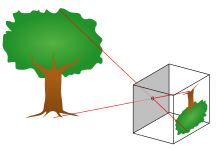Wikijunior:How Things Work/Camera
What is a camera?
[edit | edit source]

The word camera comes from Latin and means "room" or "chamber". The first camera was a very dark room with a tiny hole in the window shutter. Light passing through this 'pinhole' produced an image on the far wall that was bright and upside down. Someone had the bright idea of making a camera in a tower and adding mirrors. People in the dark room looked at a table, on which they saw the outside world projected - it produced a "birds-eye view" of their city.
This was called a "camera obscura". The first one was made by a scholar called Ali Al-Hasan Ibn al-Haitham. He was born in Basra (now in southern Iraq) in about the year 1000 AD.
Pinhole Camera
[edit | edit source]Around 1600, Giambattista della Porta added a lens to the pinhole camera, but it was not until 1850 that a Scottish scientist, Sir David Brewster took the first actual photograph with a pinhole camera.
Photography
[edit | edit source]Photography is the result of combining several technical discoveries
- The pinhole camera
- Optical lenses
- Photo-chemical reactions
- Chemical development and stabilization of the image
The first permanent photograph was an image produced in 1825 by the French inventor Nicéphore Niépce, but it took a very long time to produce. He teamed up with Louis Daguerre, and together they experimented with silver compounds based on a discovery made by a German Chemist Johann Heinrich Schultz in 1724, which was that a silver and chalk mixture darkens when exposed to light.
British scientist William Fox Talbot discovered another means to fix a silver process image but had kept it secret. He discovered sodium thiosulphate solution to be a solvent of silver halides in 1819 and was the first to commercialize photography and use the terms "negative" and "positive".
In around 1900 Eastman Kodak of America mass produced the first popular black-and-white camera "The Brownie" which popularized low-cost photography and introduced the concept of the snapshot. The product was a very basic cardboard box camera with a simple lens. It used rolls of photographic film capable of storing about eight or a dozen images which could be developed and printed at most pharmacies, since initially they also sold the camera and film. The result was 2¼-inch (6cm) square black and white pictures of reasonable quality which faded unless stored in the dark. Photograph albums using dark, chemically inert paper were invented for this purpose.
The first modern color film using the "three colored emulsion process" was called Kodachrome, a popular product introduced by the Eastman Kodak Company in the United States of America around 1935.
Today, electronic cameras usually use an integrated circuit that scans each point or "pixel" of an image and produces electrical signals. The basic "empty black box" is tiny compared with the darkened room, but the principle method of producing an image on a screen remains exactly the same as projecting an image on a wall of a room.
